Welcome to the world of hardy, resilient, and oh-so-cuddly canines! These 15 dog breeds are ready to embrace the great outdoors with their thick fur coats, powerful bodies, and unwavering loyalty.
They’re not just your regular couch potatoes; these pups are built to withstand the elements, making them the perfect companions for those who love spending time outside.
Whether you’re a dedicated hiker, a winter sports enthusiast, or simply someone who enjoys the crisp, fresh air, these breeds will happily snooze under the stars alongside you.
So, without further ado, let’s dive into the fascinating lives of these incredible outdoor-loving dogs!
1. Alaskan Malamute
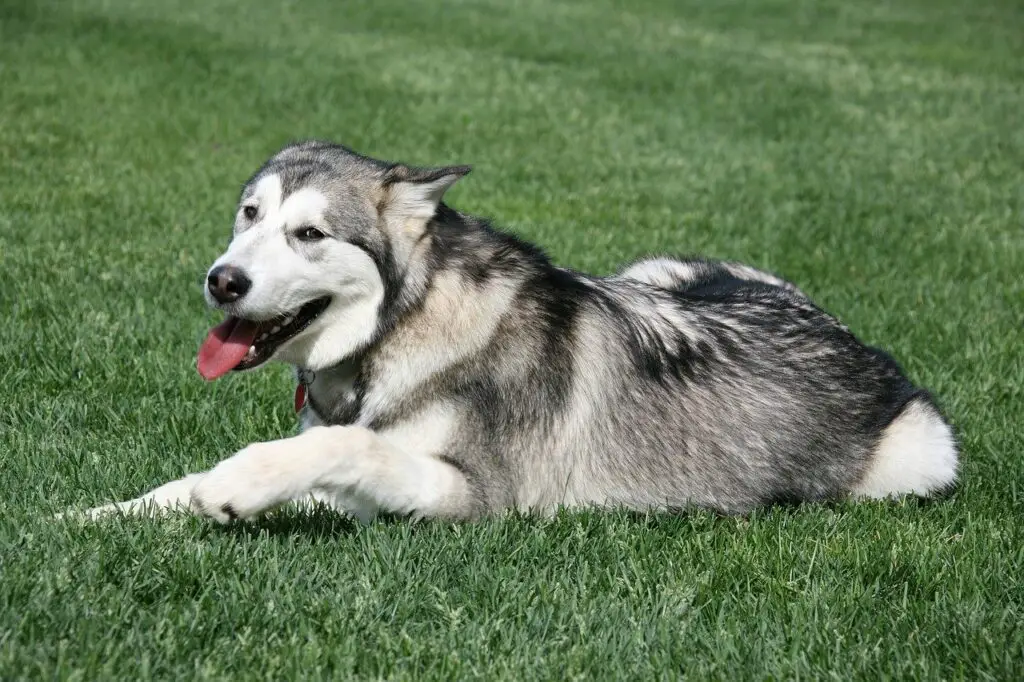
The Alaskan Malamute is a prime example of a dog breed that can comfortably sleep outside, thanks to its remarkable adaptability to harsh weather conditions.
Originating from the Arctic region, this breed was bred to work as sled dogs, pulling heavy loads over long distances in extreme cold.
Their thick double coat, consisting of a dense, woolly undercoat and a longer, coarse outer coat, provides excellent insulation against frigid temperatures.
In addition to their impressive coat, Alaskan Malamutes have a strong and sturdy build, enabling them to endure tough outdoor environments.
They also possess a natural instinct to dig and create dens, which can serve as additional protection from the elements when sleeping outside.
Despite their ability to withstand colder climates, it’s important to provide Alaskan Malamutes with proper shelter and bedding when they sleep outdoors.
Moreover, like all dog breeds, Alaskan Malamutes require human companionship and attention, so make sure they are not left isolated outside for extended periods.
2. Siberian Husky
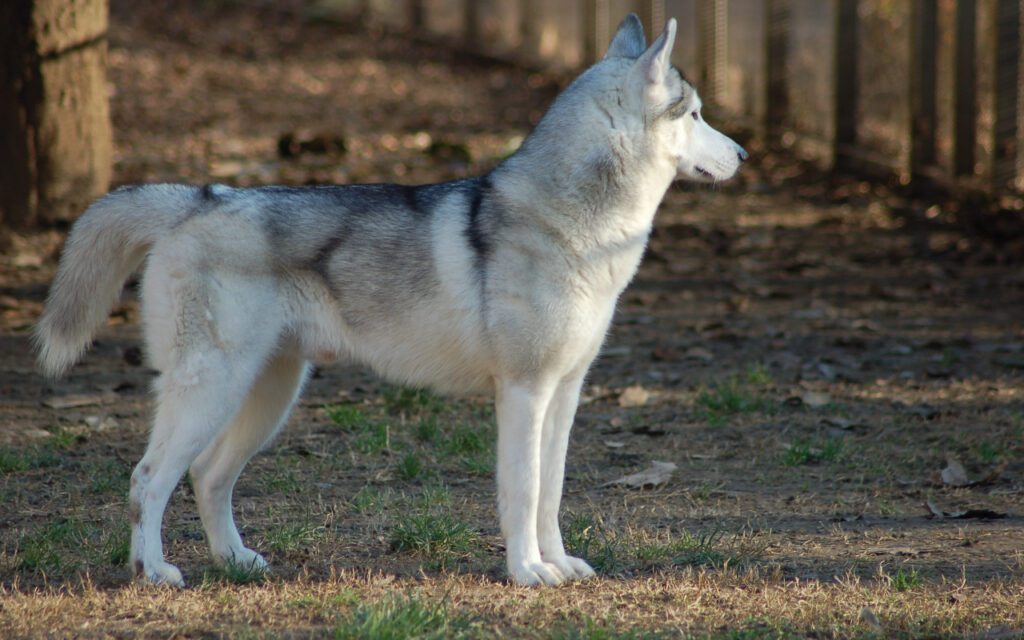
The Siberian Husky is another exceptional breed that can comfortably sleep outside due to their innate ability to withstand harsh weather conditions.
Hailing from the cold and snowy regions of Siberia, these dogs were historically used for pulling sleds over vast distances, making them well-adapted to colder environments.
Their thick double coat, which includes a dense, soft undercoat and a water-resistant outer coat, provides superb insulation against freezing temperatures.
This incredible fur also helps them regulate their body temperature, ensuring they stay warm and comfortable when sleeping outdoors in colder climates.
Siberian Huskies have a robust and athletic build, enabling them to thrive in challenging outdoor settings. Their natural inclination to dig dens or burrows can offer additional protection from wind and cold while sleeping outside.
However, it’s important to remember that Siberian Huskies still require proper shelter and bedding when sleeping outdoors.
Also, Siberian Huskies are social animals, so make sure they receive adequate human interaction and are not left isolated outside for long periods. Regular exercise and mental stimulation are essential for this energetic and intelligent breed.
3. Bernese Mountain Dog
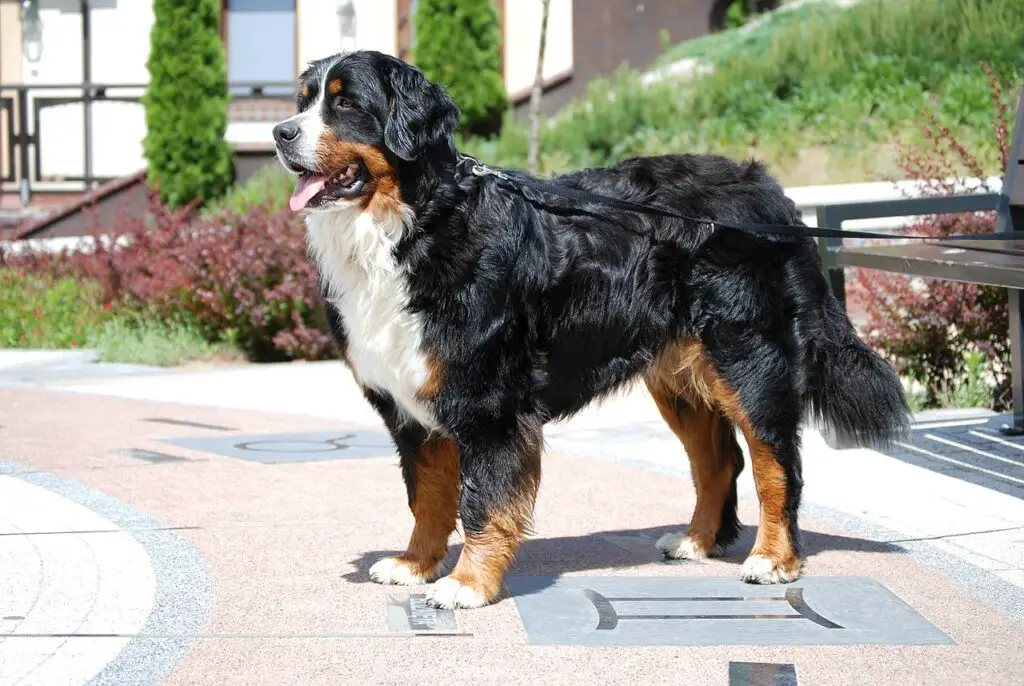
The Bernese Mountain Dog is yet another breed well-equipped to sleep outside, thanks to its remarkable ability to adapt to various weather conditions.
Originating from the Swiss Alps, these dogs were historically used as working dogs on farms, where they pulled carts, herded livestock, and served as watchdogs. Their exposure to the alpine climate has made them well-adapted to colder environments.
Their thick double coat, consisting of a longer outer coat and a dense undercoat, provides excellent insulation against cold temperatures. This luxurious fur helps keep them warm and cozy when sleeping outdoors in cooler climates.
Bernese Mountain Dogs have a strong and muscular build, which allows them to thrive in demanding outdoor settings. While they don’t typically dig dens like some other breeds, their sturdy physique and heavy coat offer ample protection from the elements.
Despite their ability to withstand colder climates, it’s essential to provide Bernese Mountain Dogs with proper shelter and bedding when they sleep outside.
Additionally, Bernese Mountain Dogs are known for their affectionate and gentle nature, so it’s important to ensure they receive plenty of human interaction and are not left isolated outside for extended periods. Regular exercise and mental stimulation are also crucial for this intelligent and loyal breed.
4. Great Pyrenees
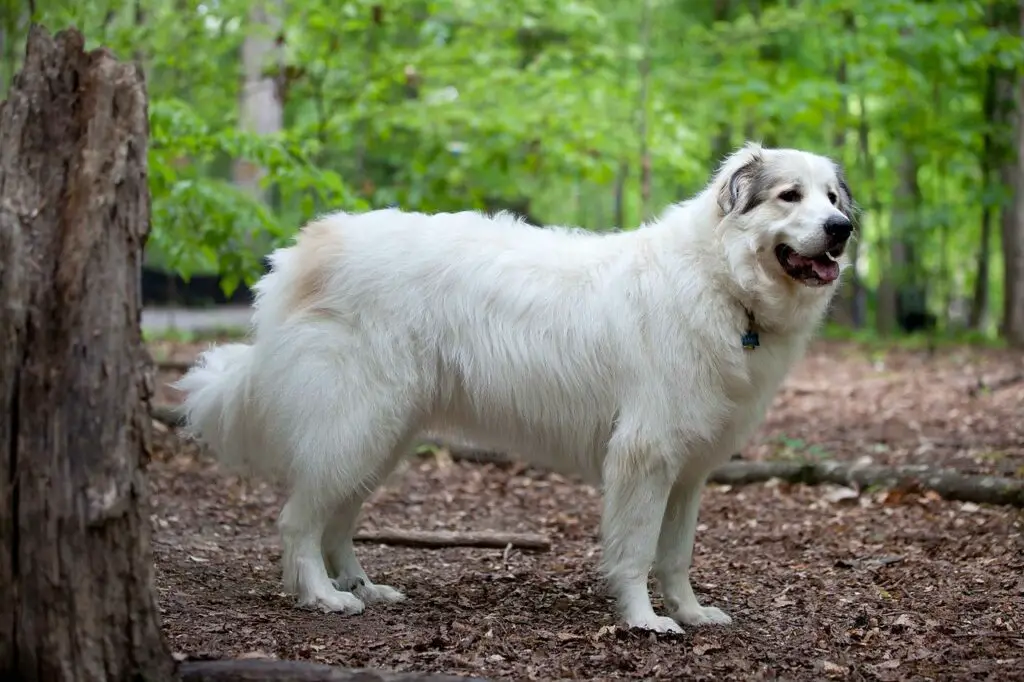
The Great Pyrenees is a prime example of a dog breed that can comfortably sleep outside, thanks to its incredible ability to adapt to various weather conditions.
Originally bred in the mountainous regions of France and Spain, these dogs were used as livestock guardians, protecting sheep from predators such as wolves and bears. Their exposure to the harsh mountain climate has made them well-adapted to colder environments.
Their magnificent double coat, featuring a dense, woolly undercoat and a longer, weather-resistant outer coat, provides superb insulation against cold temperatures. This thick fur helps keep them warm and comfortable when sleeping outdoors in cooler climates.
Great Pyrenees have a powerful and muscular build, which enables them to thrive in challenging outdoor settings. While they don’t typically dig dens like some other breeds, their large size and heavy coat offer ample protection from the elements.
5. Newfoundland
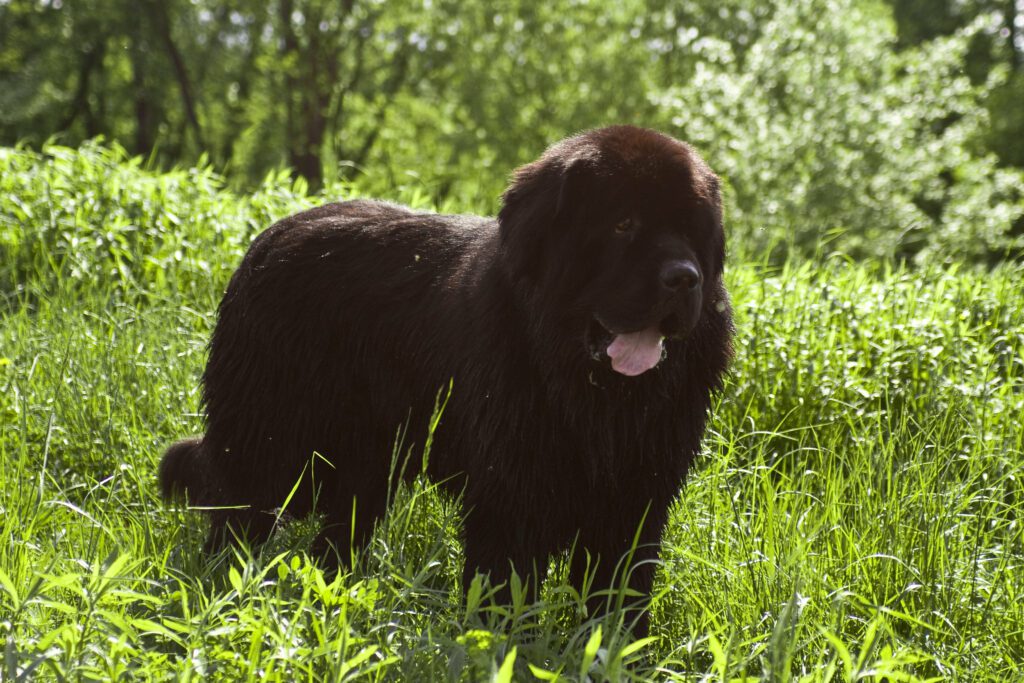
The Newfoundland is another breed that can comfortably sleep outside due to their extraordinary adaptation to various weather conditions.
Hailing from the Canadian province of Newfoundland, these dogs were primarily used as working dogs in cold and wet environments, assisting fishermen with hauling nets and rescuing people from the water. Their ability to thrive in such conditions makes them well-suited for colder climates.
Their impressive double coat consists of a soft, dense undercoat and a long, water-resistant outer coat. This combination provides excellent insulation against cold temperatures, keeping them warm and cozy when sleeping outdoors in cooler climates.
Newfoundland dogs have a sturdy and muscular build, which allows them to endure challenging outdoor settings. Their large size and heavy coat offer ample protection from the elements, making them well-equipped to handle colder environments while sleeping outside.
6. Saint Bernard
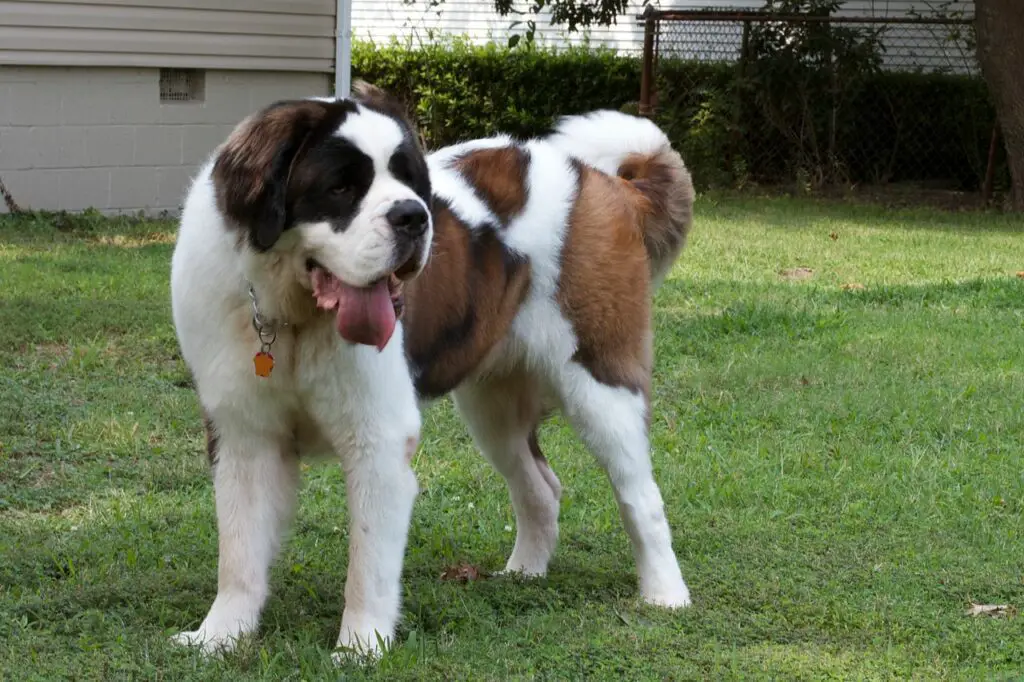
Saint Bernard is a dog breed that can comfortably sleep outside, given its remarkable adaptation to various weather conditions.
Originating from the Swiss Alps, these dogs were historically used as rescue dogs, helping to locate and save travelers trapped in avalanches or lost in the snowy mountains. Their exposure to harsh alpine climates has made them well-adapted to colder environments.
Their dense double coat features a soft undercoat and a longer, protective outer coat, providing excellent insulation against cold temperatures. This thick fur ensures that they stay warm and comfortable when sleeping outdoors in cooler climates.
Saint Bernards have a solid and muscular build, which enables them to thrive in demanding outdoor settings. Their large size and heavy coat offer ample protection from the elements, making them well-suited for colder environments while sleeping outside.
7. Anatolian Shepherd
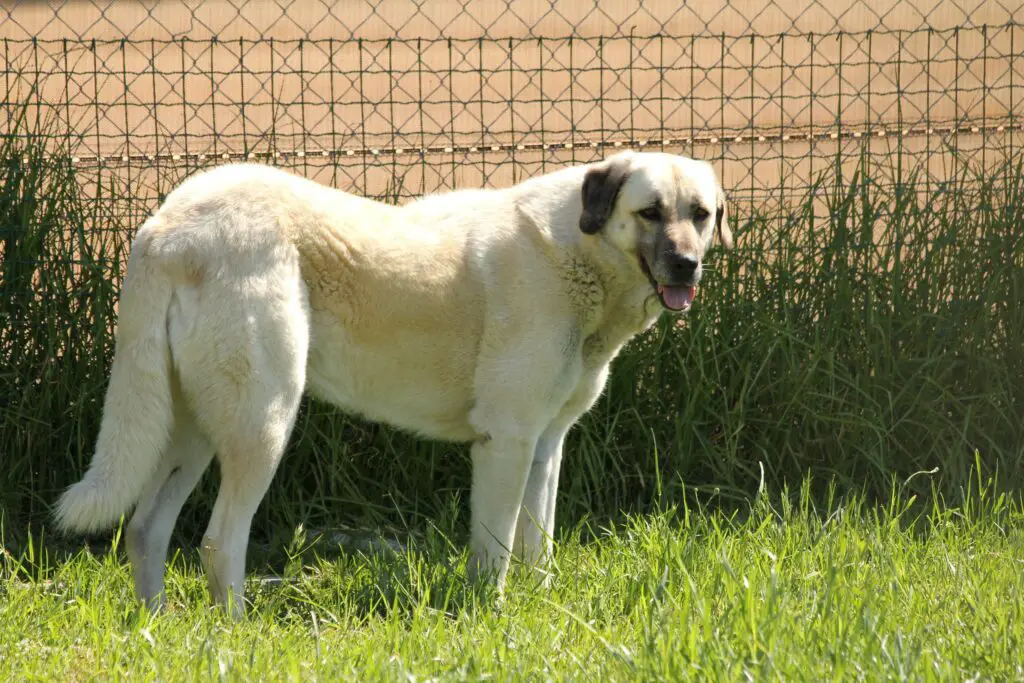
The Anatolian Shepherd is a large, powerful, and ancient dog breed originating from the region of Anatolia in Turkey.
Bred for thousands of years to protect livestock from predators, these dogs are known for their exceptional courage, loyalty, and intelligence.
Their strong instincts and natural guarding abilities make them excellent working dogs, but they can also be wonderful companions for experienced dog owners who understand their unique temperament.
One of the most notable traits of Anatolian Shepherds is their ability to sleep outside in various weather conditions. This resilience is primarily due to their thick, double-layered coat, which provides ample insulation against both cold and heat.
The outer coat is short to medium in length and slightly coarse, while the undercoat is soft and dense. This combination offers excellent protection against harsh climates, making it possible for these dogs to comfortably sleep outdoors.
In addition to their remarkable coat, Anatolian Shepherds possess a strong, muscular body that helps them endure the elements. They have a well-developed chest, powerful legs, and a broad head, all of which contribute to their overall hardiness.
While Anatolian Shepherds can tolerate sleeping outside, they should still have access to proper shelters. I am talking about a dog house or a covered area, to protect them from extreme weather conditions.
Providing fresh water and regular health check-ups are also essential to ensure their well-being.
8. Akita
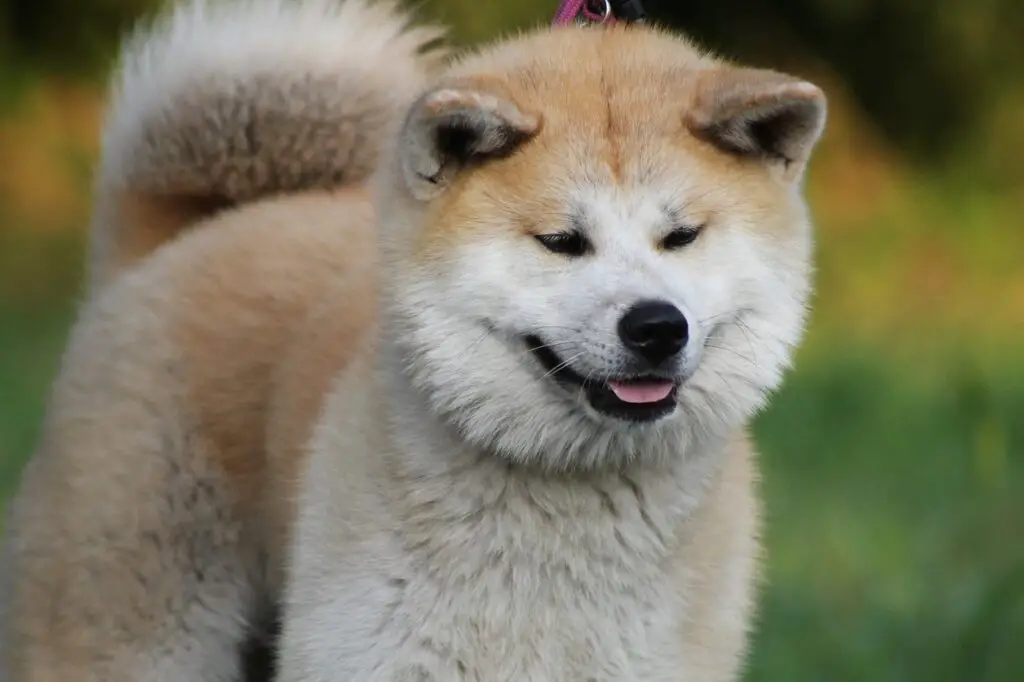
The Akita is a large and powerful dog breed that originated in Japan. Known for their loyalty, courage, and strong guarding instincts, Akitas have been bred over centuries to work as a versatile hunting and guarding dogs.
Their physical characteristics and natural adaptability make them capable of staying outside for extended periods, even in challenging weather conditions.
One of the primary reasons Akitas can stay outside is their dense, double-layered coat. The outer coat is comprised of straight, coarse hairs, while the undercoat is soft, thick, and insulating. This dual-layered fur provides excellent protection against both cold and hot temperatures, allowing Akitas to withstand various climates comfortably.
In colder environments, the Akita’s coat traps warm air close to the skin, acting as insulation against frigid temperatures.
During warmer months, the coat helps protect the dog from direct sunlight and heat, while also serving as a barrier to prevent overheating. Akitas also shed their undercoat seasonally, which helps them adapt to changing temperatures throughout the year.
Akitas possess a robust and muscular build, which contributes to their ability to withstand harsh outdoor conditions.
They have a solid, well-balanced body structure, with strong legs and a broad chest, enabling them to endure the elements and maintain their stamina while outdoors.
9. German Shepherd
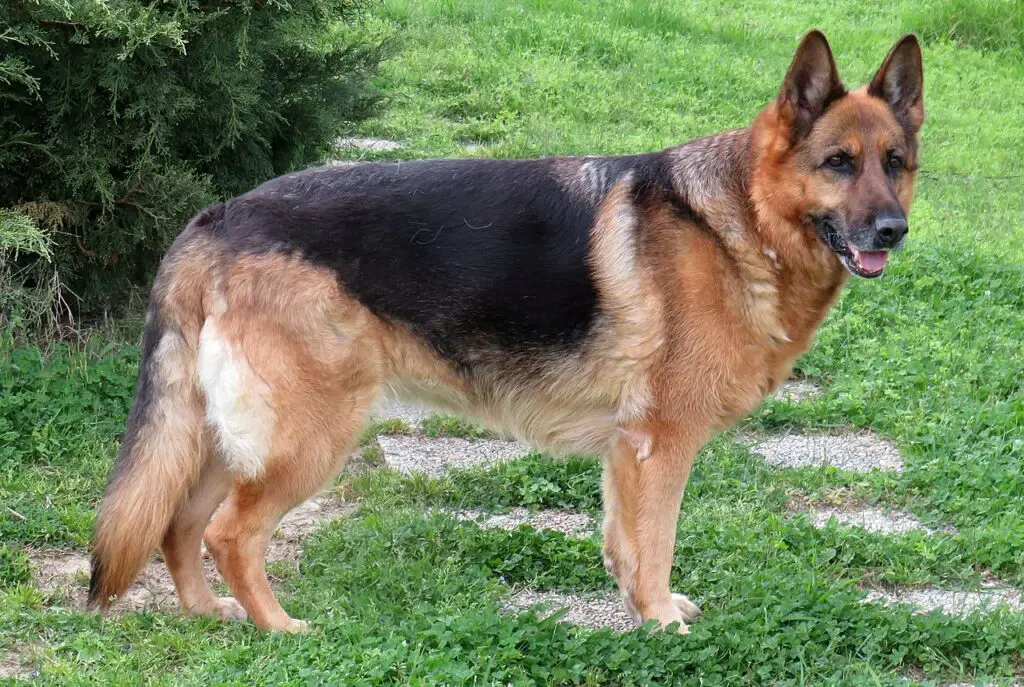
German Shepherds are a versatile and highly adaptable dog breed, originally developed in Germany for herding and guarding livestock. Over time, they have become popular working dogs in various fields, such as police work, search and rescue, and service animals.
Their physical characteristics and inherent resilience make them capable of staying outside in a range of weather conditions.
One of the key reasons German Shepherds can stay outside is their double-layered coat. The outer coat consists of dense, straight hairs that are slightly harsh to the touch, while the undercoat is soft, and thick, and provides insulation.
This combination offers excellent protection against both cold and hot temperatures, enabling German Shepherds to adapt to various climates comfortably.
In colder environments, the double-layered coat traps warm air close to the skin, insulating the dog from frigid temperatures. In warmer climates, the coat serves as a barrier against direct sunlight and heat, helping to prevent overheating.
German Shepherds also shed their undercoat seasonally, which aids in adapting to changing temperatures throughout the year.
In addition to their protective coat, German Shepherds possess a strong and agile build that contributes to their ability to withstand outdoor conditions.
They have a well-proportioned body with powerful legs and a deep chest, allowing them to maintain stamina and endurance while outdoors.
10. Belgian Malinois
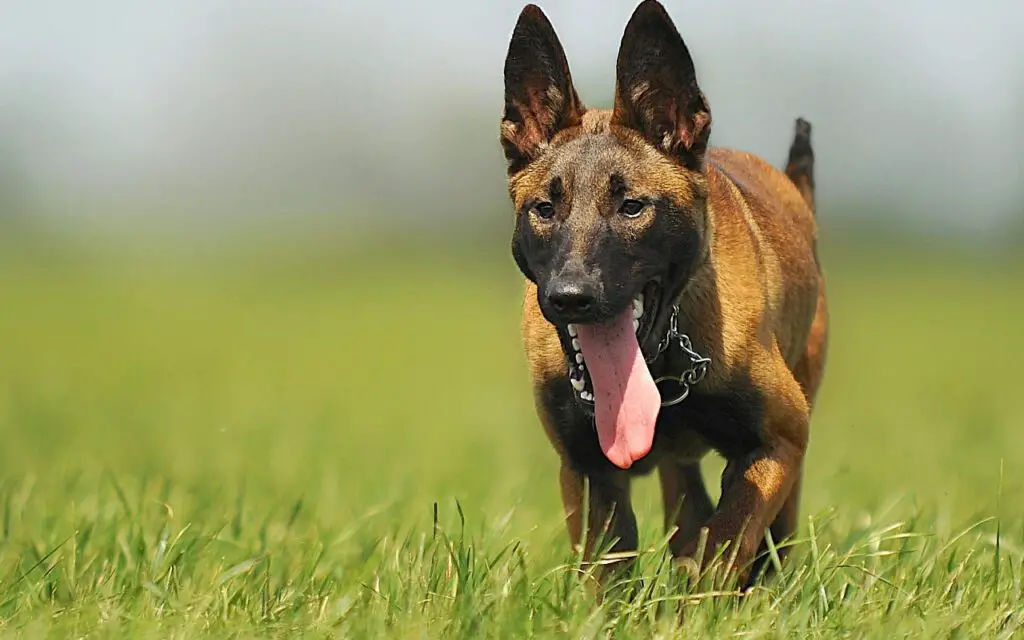
The Belgian Malinois is a highly intelligent and versatile breed known for its exceptional work ethic, agility, and resilience. They are often employed in various roles such as police work, search and rescue, and military operations due to their remarkable adaptability and high energy levels.
When it comes to staying outside, Belgian Malinois can indeed thrive in various environments, including spending extended periods outdoors. However, there are some essential factors to consider when planning to keep your Belgian Malinois outside.
Weather conditions: Belgian Malinois have a dense, weather-resistant double coat that insulates them from both cold and heat. This coat allows them to withstand a wide range of temperatures, but extreme weather conditions can still be harmful.
In scorching climates, it’s essential to provide adequate shade and water to prevent overheating. Similarly, during extremely cold weather, ensure they have proper shelter and insulation to keep warm.
Physical activity: Belgian Malinois is an energetic breed that requires rigorous daily exercise to stay mentally and physically fit. If they are kept outside, make sure they have ample space to run, play, and explore. Regularly engaging them in activities like fetch, agility training, or long walks will help keep them happy and healthy.
11. Australian Cattle Dog
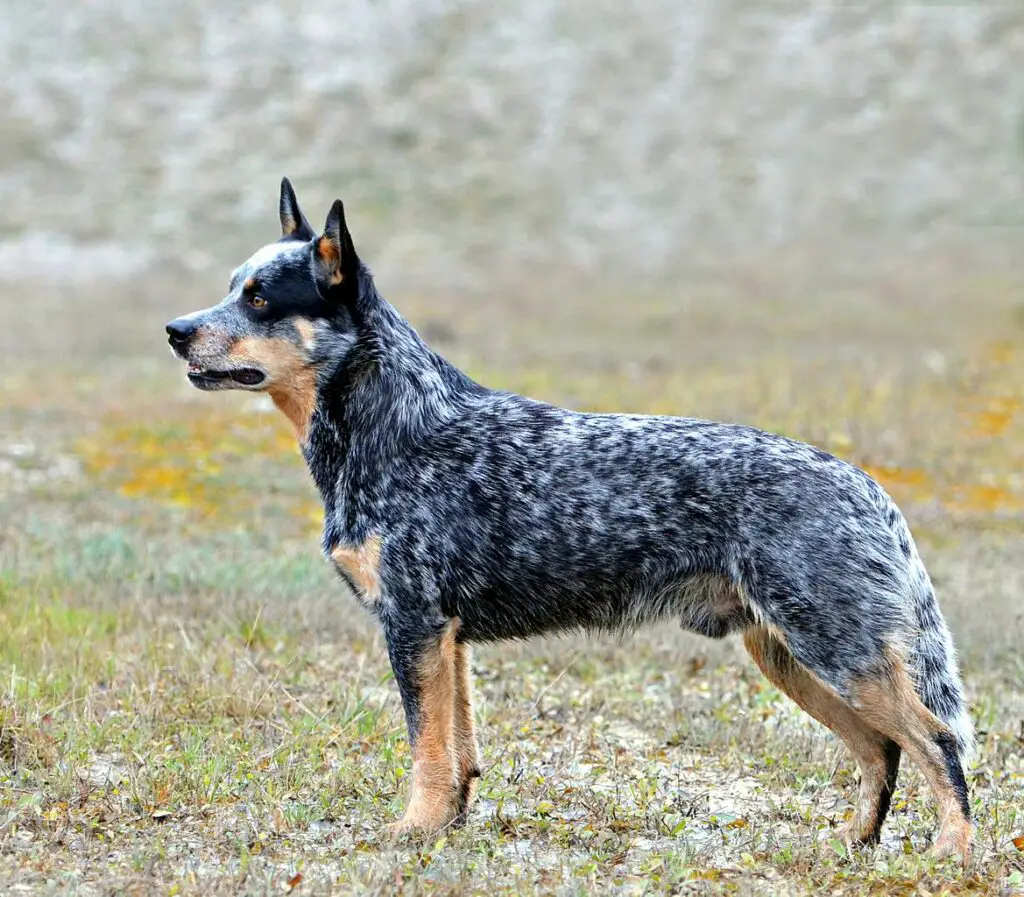
Australian Cattle Dogs are a robust and hardy breed, well-suited to spending time outdoors due to their origins as working dogs on Australian ranches. They have the physical and mental attributes necessary to adapt to various outdoor environments.
However, there are some crucial factors to consider when planning to keep an Australian Cattle Dog outside for extended periods.
Weather conditions: Australian Cattle Dogs have a dense double coat that provides insulation against both cold and heat. This coat allows them to handle a range of temperatures, but extreme weather conditions can still pose risks.
In hot climates, ensure that your dog has access to shade and fresh water to prevent overheating. During extremely cold weather, proper shelter and insulation are essential to keep your dog warm and comfortable.
Physical activity: Being energetic and athletic, Australian Cattle Dogs require plenty of daily exercises to maintain their physical and mental well-being. If they are kept outside, it’s important to provide ample space for them to run, play, and explore. Engaging in activities like fetch, agility training, or long walks will help keep them happy and healthy.
Social interaction: While Australian Cattle Dogs can spend considerable time outdoors, they are social animals that need regular interaction with their human family. Prolonged isolation can lead to behavioral issues such as separation anxiety or aggression. Be sure to spend quality time with your dog, even if they are primarily kept outdoors.
Safety and security: When keeping your Australian Cattle Dog outside, it’s critical to have a secure and safe environment. A strong, fenced area will help protect your dog from potential hazards and discourage escape attempts. Additionally, ensure that the outdoor space is free from toxic plants or objects that could harm your dog.
12. Rhodesian Ridgeback
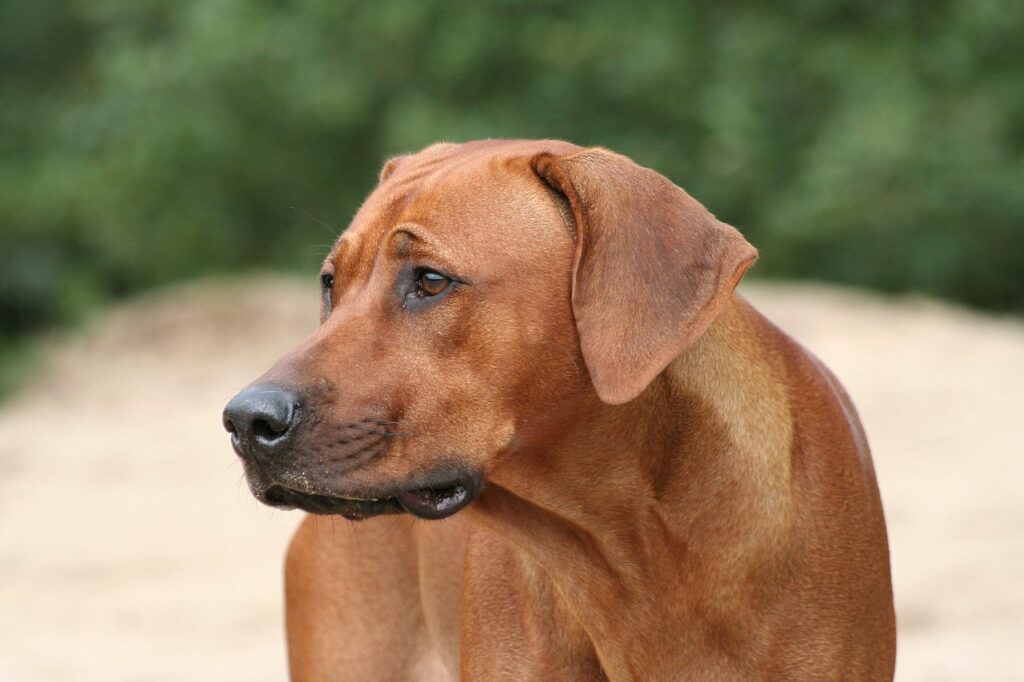
Rhodesian Ridgebacks are a breed of dog known for their adaptability and resilience, which allows them to comfortably stay outside for extended periods. Here are some reasons why Rhodesian Ridgebacks can handle outdoor living:
- Weather-resistant coat: Rhodesian Ridgebacks have a short, dense coat that is weather-resistant. This provides them with natural protection against various weather conditions such as rain, cold, and heat. Their coat also requires minimal grooming, making them suitable for outdoor living.
- Origins and breeding: This breed was originally developed in Southern Africa for hunting and guarding purposes. They were bred to withstand harsh African climates, which contributed to their ability to thrive in various environments.
- High energy and endurance: Rhodesian Ridgebacks are known for their high energy levels and stamina. These traits are beneficial for a dog that spends a significant amount of time outdoors, as they can cope well with physical activities and long periods of exercise.
- Independence: Ridgebacks are known for their independence and self-reliance. While they enjoy human companionship, they can also entertain themselves and manage without constant supervision. This makes them suitable for spending time outside.
- Adaptability: The breed is highly adaptable and can adjust to different living conditions, whether it’s an urban apartment or a rural farm. Their adaptability extends to their ability to handle various weather conditions and environments when staying outside.
However, it’s important to note that Rhodesian Ridgebacks, like all dogs, need proper shelter, food, water, and attention from their owners.
13. Irish Wolfhound
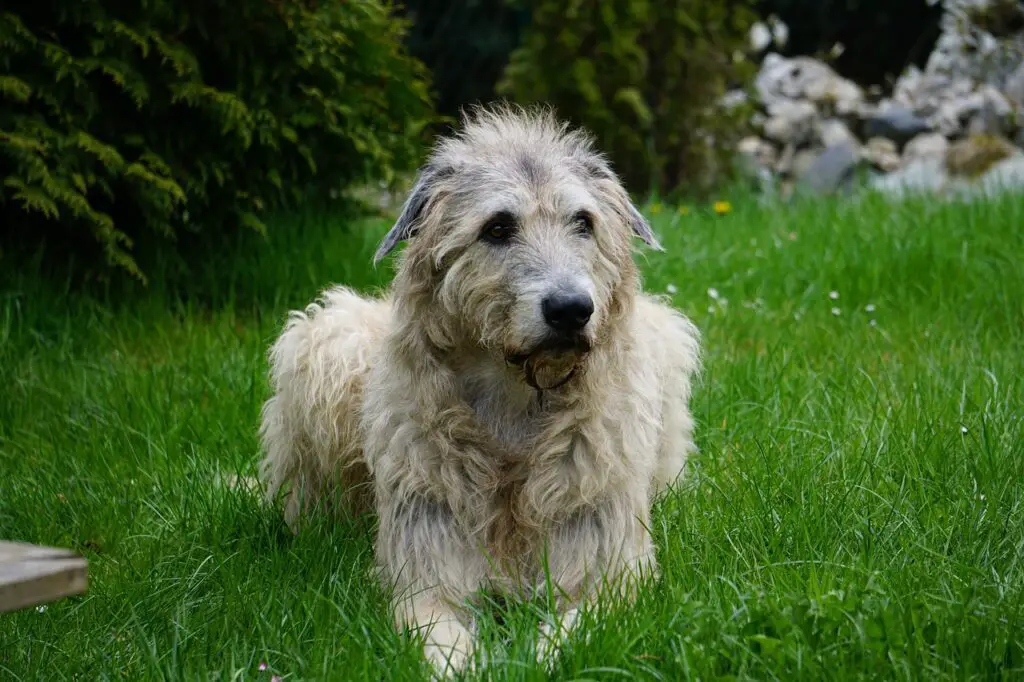
Irish Wolfhounds are a large and hardy breed, originally bred for hunting and guarding purposes in Ireland.
They have a rough, weather-resistant coat that helps protect them from the elements. Despite their size and adaptability to outdoor conditions, there are several factors to consider before letting an Irish Wolfhound stay outside for extended periods.
- Climate: Irish Wolfhounds can tolerate colder climates due to their thick coats. However, they may struggle in extreme heat or cold. In very hot weather, they can be prone to overheating. So, it’s essential to provide them with shelter and plenty of water. Similarly, in extremely cold temperatures, ensure they have access to a warm, insulated shelter.
- Socialization: Irish Wolfhounds are social animals and thrive on human interaction. Leaving them outside for long periods without sufficient companionship can lead to loneliness, boredom, and potentially destructive behavior. It’s important to spend quality time with your dog and engage them in regular play and exercise.
- Safety and Security: When leaving an Irish Wolfhound outside, ensure they have access to a secure, enclosed space, such as a fenced yard. This will help prevent them from wandering off or encountering potential dangers, like traffic or aggressive animals.
- Shelter and Comfort: Provide your Irish Wolfhound with a comfortable and weather-appropriate shelter. This should include a well-insulated dog house with ample space for them to move around, along with bedding that can keep them warm during colder months and cool during warmer months.
- Health Considerations: Regular grooming is necessary to maintain their coat’s health and prevent matting. Also, ensure they receive regular veterinary check-ups and vaccinations to keep them healthy and protected from common diseases.
14. Scottish Deerhound
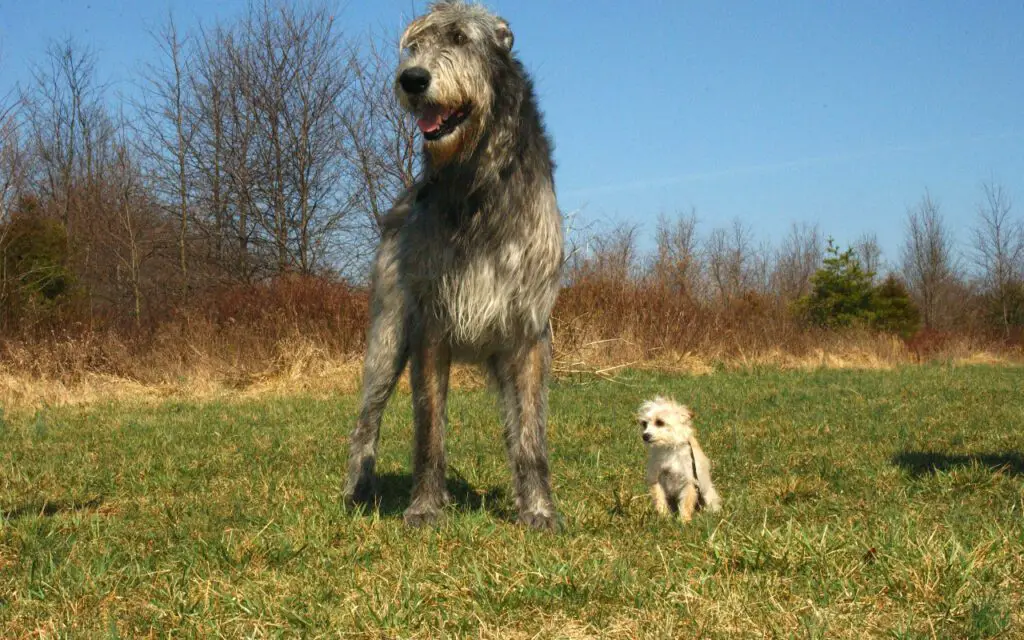
The Scottish Deerhound, a large and majestic breed known for its elegant appearance and gentle temperament, is not well-suited for extended periods of outdoor living.
While they may enjoy spending time outside during mild weather conditions, their thin coats provide minimal insulation against the cold, making them particularly vulnerable to harsh climates.
Furthermore, these dogs crave human companionship and interaction, which is essential for their emotional well-being.
Keeping a Scottish Deerhound outside full-time could lead to feelings of isolation, and boredom, and even result in destructive behaviors.
15. Rottweiler
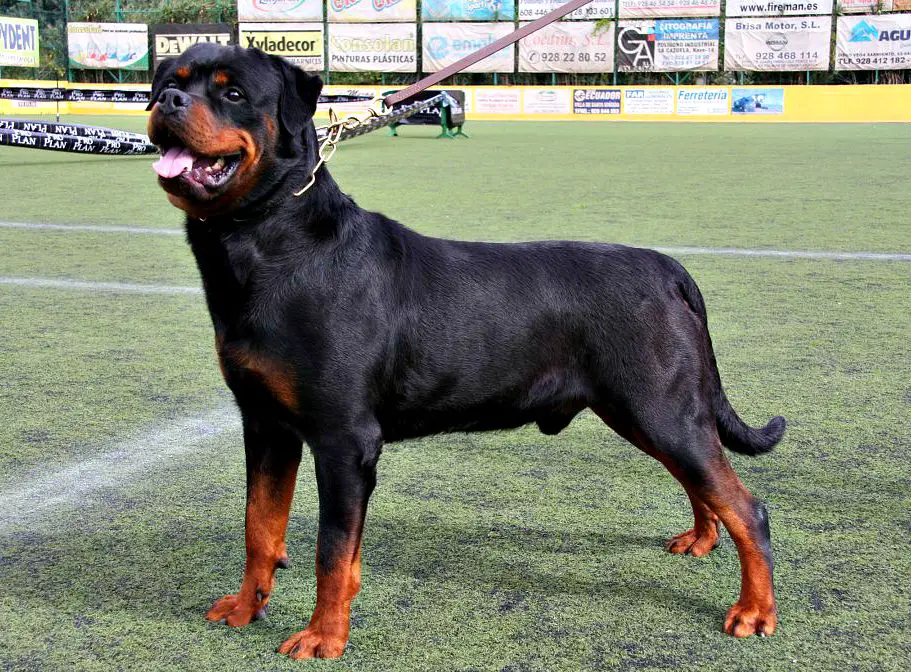
The Rottweiler, a robust and powerful breed known for its loyalty and protective instincts, has a higher tolerance for outdoor living than many other breeds.
With their thick, double-layered coat, Rottweilers can withstand colder temperatures and are more adaptable to various weather conditions.
However, this does not mean they should live exclusively outdoors. Like any dog, Rottweilers need regular human interaction and socialization to maintain their mental and emotional well-being.
Extended periods of isolation may lead to boredom, anxiety, or even aggression. If you plan to keep your Rottweiler outside for extended periods, ensure they have access to a secure, sheltered area that protects them from extreme weather conditions, and provide ample opportunities for exercise and social interaction.
Ultimately, the best environment for a Rottweiler is one that balances both indoor family time and outdoor activities, ensuring their physical and emotional needs are met.
In Conclusion
These 15 dog breeds that can sleep outside have proven their resilience and adaptability to various weather conditions, making them exceptional companions for outdoor enthusiasts.
While they are well-suited to thrive in the great outdoors, it’s essential to remember that each dog is unique, and their individual needs must be met with proper shelter, bedding, and care.
As long as these wonderful canine companions are provided with love, attention, and the necessary protection from extreme weather, they will gladly join you on countless adventures, always ready to curl up under a starry sky and dream of more escapades to come.





Leave a Reply